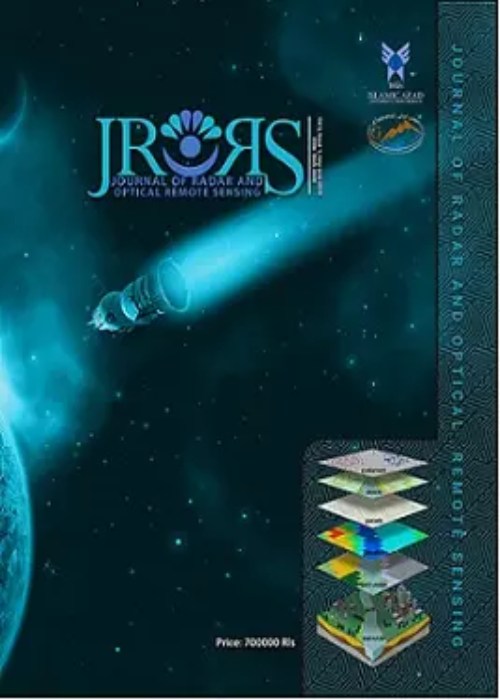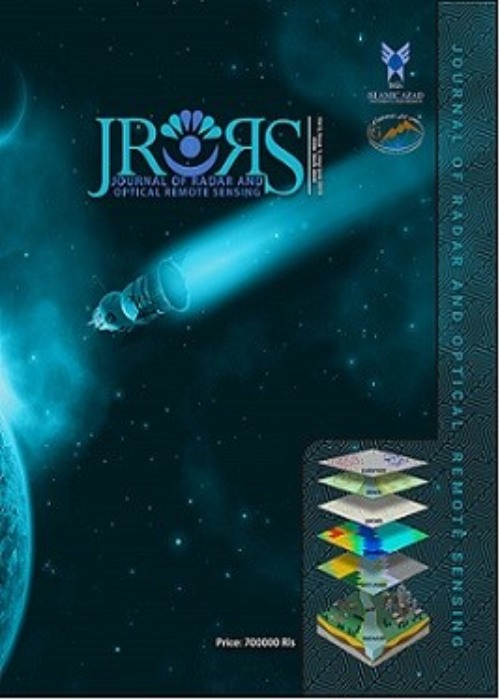فهرست مطالب

Journal of Radar and Optical Remote Sensing
Volume:6 Issue: 1, Winter 2023
- تاریخ انتشار: 1402/03/08
- تعداد عناوین: 6
-
Pages 7-20Land Subsidence often causes irreversible damage to infrastructures and costs lots of expenses for governments annually; Hence, studying and monitoring subsidence in either plains or urban areas has become necessary in last decades. Studies have introduced excessive depletion of aquitards as the dominant factor in the occurrence of this hazard. In this study, the main aim was to take the impact of other spatial factors involving land subsidence into consideration. To devise a plan whether to pause or reduce the subsidence rate, we need to understand the mechanism of each factor inducing land subsidence. Here, we show the outcomes of a Geographically Weighted Regression (GWR) method with a fixed Gaussian kernel to identify the impact of each of the spatial factors inducing subsidence compared with the results from a Multi Linear Regression (MLR). In this regard, outputs of a compiled Interferometric Synthetic Aperture Radar (InSAR) time series analysis of the 15 Envisat ASAR images consumed to capture displacement from 2003 to 2005. Afterward, a kriging interpolation method is implemented to generate a surface of subsidence. The Python package "mgwr" is used to compile both GWR and MLR models. Several statistical diagnostics are performed to assert the GWR superiority over other non-geographical methods when dealing with spatial data. Finally, the GWR results show that just six factors out of 10 tend to be the dominant factors.Keywords: Subsidence, Multi Linear Regression, Geographically weighted regression, InSAR
-
Pages 21-40Today, the electricity industry is considered one of the most vital industries of a country, and considering that the passage of electricity transmission lines in each region has different effects and radiation depending on its voltage, so in order to preserve human health, plant growth and prevent financial losses, Privacy must be respected. One of the optimal methods in semi-automatic monitoring and monitoring of illegal constructions is the use of remote sensing and the use of radar images. In this research, Sentinel1 radar time series images were used to monitor the security of transmission and super distribution lines, which after applying pre-processing Necessary in SNAP software, In order to extract the zero sigma dispersion coefficient of the images and make them binary, 100 sample points were taken as a statistical population from the Landsat images and the threshold limit of the construction of two images were calculated and the number 0.081003 was obtained as the threshold limit, and then by creating the privacy layer of the transmission network and overlaying it with the fuzzy images, the amount of interference The constructions were determined by the structure of the network privacy and also the illegal constructions were identified during one year with the pixel-based algorithm and at the end drone images were used for validation, the results of this research indicate that most of the illegal constructions can be identified using the method presented It was identified semi-automatically with 85-90% accuracy and increased the speed of identifying illegal constructions in privacy.Keywords: Radar images, Sentinel 1 satellite, Time series, pixel-based algorithm, zero sigma dispersion coefficient
-
Pages 41-50Today, various pollutants enter the air due to human actions, biological activities and natural factors and endanger human life. Among the nitrogen oxides in the air, (NO2) is one of the most important pollutants, and dust is one of the most important harmful climate phenomena. In this regard, the aim of this research is to investigate the dust map and nitrogen dioxide concentration map in Mashhad and Shiraz regions and their effects in these regions. This study investigates and compares the dust volume and nitrogen dioxide concentration in Mashhad and Shiraz regions. And their relationship with land use, wind intensity and vegetation has been analyzed using satellite images and model maps through Google Earth Engine, a specialized web-based remote sensing system. The results show that the concentration of nitrogen dioxide is related to the land use of the cities in such a way that in industrial areas and urban centers that are mostly commercial and administrative, and it causes population density and increased transportation in these areas, the increase in the concentration of nitrogen dioxide In addition, there is an indirect relationship between wind intensity and nitrogen dioxide concentration. Also, dust, vegetation and wind intensity are related to each other, so that wind intensity is directly related to the amount of dust and increases its effects. Also, there is less dust in areas with more vegetation.Keywords: Dust map, nitrogen dioxide concentration map, Shiraz, Mashhad
-
Pages 51-56
In recent years, the importance of environmental protection has increased. On the other hand, the phenomenon of urbanization, which is increasing every day, is one of the main challenges of climate and environmental changes. To control and manage the conditions, it is very important to pay attention to the concept of ecological development. This concept has a long history and theorists such as Sarda, Howard, Geddes have studied the form and human life in the field of urban planning. In this descriptive-analytical article, according to the records and opinions of experts, based on 12 criteria, the assessment and prioritization of the ecological indicators of Yazd city were discussed. In reviewing the results, the neighborhood security index with a weight of 0.2345 was the most important and the private vehicle ownership index with a weight of 0.0092 was the least important. According to the purpose of the research, which considered the ecological limitation, solutions were proposed, which are: carrying out urban development plans using multi-criteria decision-making and paying attention to the power of the environment, strengthening the security body of the city, strengthening the engineering and expert body of the municipality. Use of correct and more accurate field studies, wider study with more number of ecological criteria.
Keywords: Ecological index, yazd, AHP -
Pages 57-71Yasuj is one of the southern cities of Iran and the capital of Kohgiluyeh and Boyer-Ahmad Provinces. The city is also the center of Boyer-Ahmad County, which is located in the northeast of the province. Yasuj city ends from the north to Dena city (Kohgiluyeh and Boyer-Ahmad), from the south to Noorabad Mamasani (Fars), from the east to Semirom (Isfahan) and Eghlid (Fars) and from the west to Kohgiluyeh city. Yasuj city is located at an altitude of 1870 meters above sea level. Yasuj has important geographical and human characteristics that have an important place in its surrounding area. In terms of natural characteristics of components such as rainfall, temperature, wind, water and topography and in terms of human characteristics of population, age groups, unemployment rate, employment rate, active population, the issue of migration is significant. In this research, by studying study and research sources as well as various statistics, human and geographical features of Yasuj city are analyzed.Keywords: Yasuj, Kohgiluyeh, Boyerahmad, Geography
-
Pages 72-91In recent decades, the city of Tehran has experienced vast changes in its various levels with the increase in population and various activities and infrastructures related to it, and these human activities and changes in land use on an urban scale lead to an increase in temperature and the formation of urban heat islands. has been This issue has become one of the serious challenges and has occupied the minds of the scientific community. Considering the importance of the topic, the purpose of this research was to model thermal islands according to the environmental factors of Tehran city. The research conducted is based on a quantitative, descriptive-analytical method. First, Landsat 5 and 8 satellite images were obtained to calculate the surface temperature of the earth using TM, OLI, TIRS sensors from the United States Earth Science Base, related to the summer season of 2010 and 2021, identification of high-risk and low-risk urban heat island clusters from the global Moran test (spatial Moran autocorrelation) and local Moran (hot spot and cold spot analysis) were performed. After ensuring that the spatial distribution pattern of urban heat island is clustered, high-risk and low-risk clusters of urban heat island were identified. According to the spatial distribution pattern of high-risk and low-risk clusters, the possible influencing factors such as height, slope, direction, solar radiation, traffic density, etc., were investigated and analyzed. In the ordinary least squares (OLS) model, the three independent variables of height, vegetation and construction density had the greatest influence in the model.Keywords: spatial statistics, Tehran, urban thermal island, remote sensing, GIS


